Are you ready to take a trip down memory lane? There’s something special about the retro vibes of yesteryears that can bring warmth and character to your living space. This post is all about celebrating those nostalgic moments with 30+ retro living room ideas that will help you create a cozy yet stylish atmosphere at home. Whether it’s the bright colors, funky patterns, or classic mid-century modern furniture, I wanted to pull together these ideas for anyone looking to add a touch of vintage charm to their living space.
If you’re a fan of home decor that tells a story, you’ve come to the right place. Perhaps you love rummaging through thrift stores for vintage home accessories, or maybe you have a soft spot for retro color palettes that remind you of childhood memories. No matter your style, this post is designed for all of you who appreciate the unique beauty of classic living room styles with a modern twist.
So, what can you expect to find here? You’ll discover practical tips to incorporate nostalgic decor elements into your home, from the perfect mid-century modern furniture pieces to eye-catching retro lighting fixtures. You’ll learn how to layer textures, play with patterns, and bring in unique finds that reflect your personality. Get ready to create a space that’s not only beautiful but also feels like home.
Remember, it’s all about mixing old with new to strike that perfect balance. Let’s dive into these retro living room ideas and transform your space into a nostalgic haven that you’ll love coming back to.
Key Takeaways
– Explore over 30 unique retro living room ideas to create a space filled with nostalgia and character.
– Learn how to use bold retro color palettes to instantly elevate the mood of your living room.
– Discover the charm of mid-century modern furniture and how to arrange it for maximum impact.
– Incorporate vintage home accessories and nostalgic decor elements to add layers of interest and depth.
– Get inspired by practical tips for mixing old and new, creating a stylish yet personal living area.
1. Go Bold with Retro Color Palettes

Colors are essential to creating a retro living room vibe. Think about using vibrant oranges, deep avocado greens, and cheerful yellows that resonate with mid-century modern aesthetics. You can create a stunning accent wall in orange, which pairs beautifully with a sleek white sofa. This fresh look has become a favorite on platforms like Pinterest, inspiring many homeowners to embrace bold hues.
To implement this color scheme, consider budget-friendly paint options that allow you to experiment with various shades. Mixing these bright colors with neutral furniture can create a balanced and inviting space. This approach ensures your living room feels energetic yet comfortable, making it perfect for gatherings with family and friends.
• Use rich oranges and yellows for a lively atmosphere.
• Pair bold colors with neutral furniture for balance.
• Choose affordable paint options to stay within budget.
• Mix different shades to create a fun, inviting vibe.
With these colorful choices, your living room will be a vibrant and welcoming retreat.
Go Bold with Retro Color Palettes
Editor’s Choice

Art3d Smoothing Tool Kit for Applying Peel and Stick Wallpaper, Vinyl Ba…
 Amazon$5.99
Amazon$5.99
Rust-Oleum 1990502 Painter’s Touch Latex Paint, Quart, Flat White 32 Fl …
 Amazon$16.98
Amazon$16.98
XINXUAN Colorful Graffiti Thinker Statue Sculptures-Colorful Decor for H…
 Amazon$19.99
Amazon$19.992. Embrace Mid-Century Modern Furniture
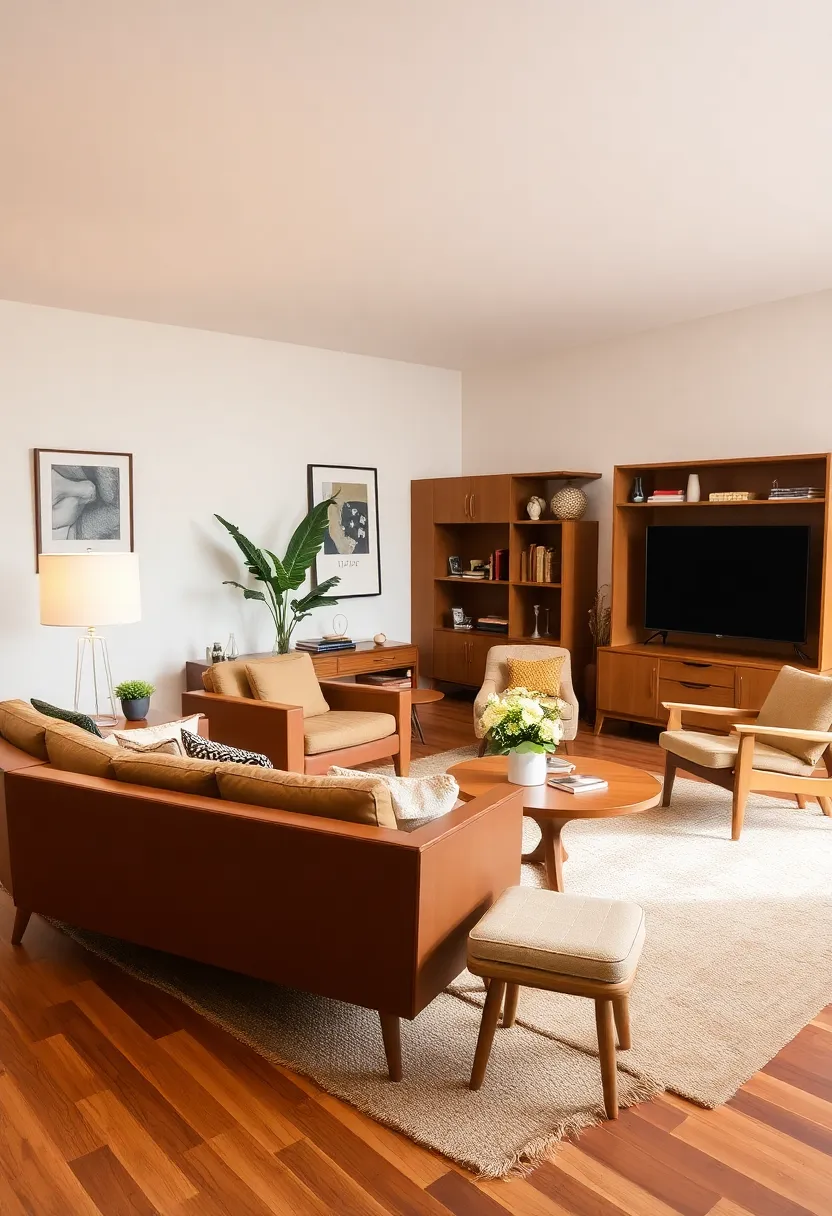
Mid-century modern furniture is a defining feature of retro living rooms. Look for pieces with sleek lines and a mix of materials like wood and metal. Iconic designs from Eames or Saarinen can serve as stunning focal points. A low-profile sofa paired with a vintage armchair creates a cozy yet stylish atmosphere.
When shopping for furniture, consider mixing vintage items with contemporary pieces to achieve a curated look. Thrift stores often have gems that fit your budget, allowing you to express your unique style. This blend creates a warm and welcoming space, perfect for relaxing or entertaining guests.
• Choose clean-lined furniture to maintain a modern feel.
• Mix vintage and contemporary pieces for character.
• Consider stylish sideboards for extra storage.
• Select items that resonate with your personal story.
By incorporating these furniture choices, your living space will radiate retro charm and comfort.
Embrace Mid-Century Modern Furniture
Editor’s Choice

Mid Century Chaise Lounge Chair with Ottoman, Top Black Grain Leather, M…
 Amazon$549.99
Amazon$549.99
SAFAVIEH Home Collection Gallium Aluminum Round Top Side Table, Silver
 Amazon$146.44
Amazon$146.44
RoyalCraft Large Sideboard Buffet Cabinet with Storage, 58” Modern Cred…
 Amazon$209.99
Amazon$209.993. Layer Textures for Depth
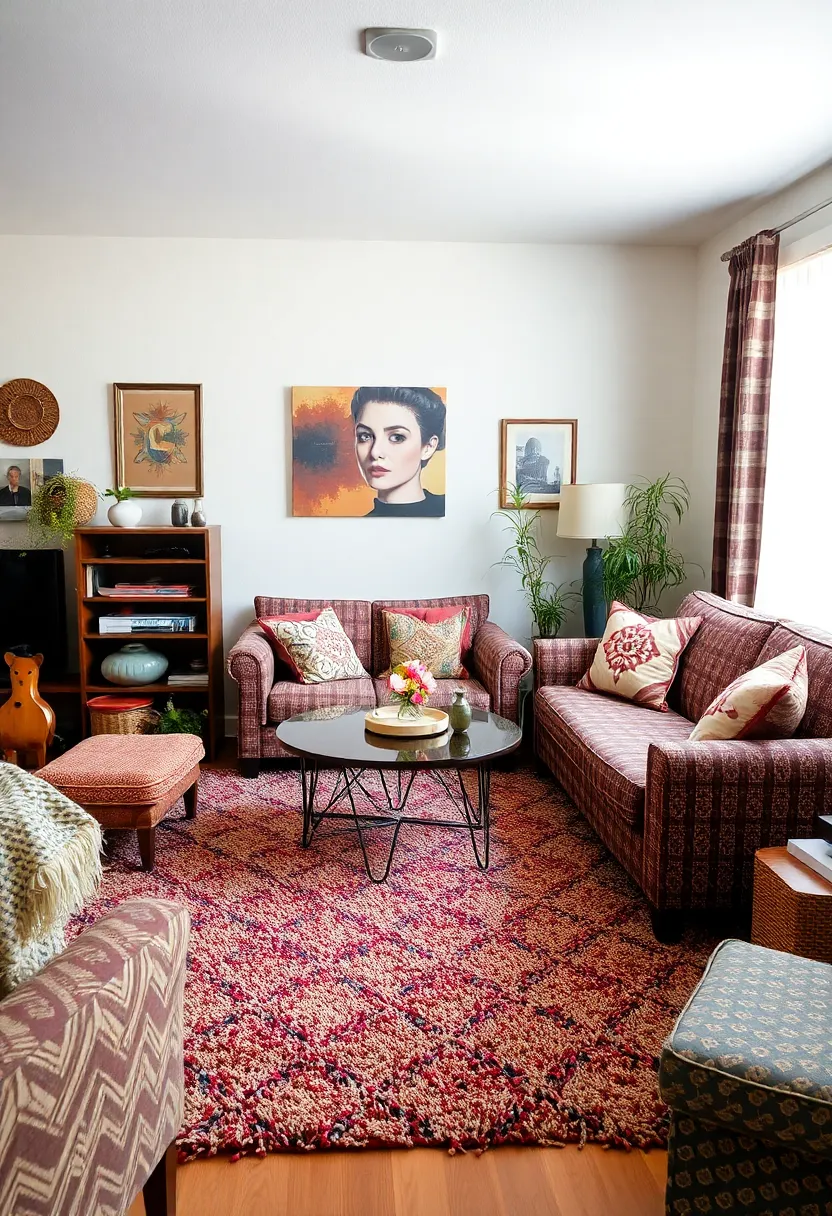
Layering textures is a fantastic way to add warmth and richness to your retro living room. Use a mix of textiles such as wool, velvet, and cotton for a cozy feel. For instance, throw pillows in various patterns provide visual interest, while a shaggy rug adds a playful touch underfoot.
Consider contrasting smooth surfaces with soft fabrics to create depth. A sleek wooden coffee table can look stunning next to a plush sofa or a leather chair paired with a knit throw. This approach invites a tactile experience, making your living space feel inviting and lived-in.
• Incorporate natural elements like plants for balance.
• Add wall textures like wood paneling for nostalgia.
• Use contrasting materials for visual intrigue.
• Layer soft fabrics to enhance comfort.
By focusing on textures, you transform your living room into a warm and welcoming haven.
Layer Textures for Depth
Editor’s Choice

MIULEE Pack of 2 Corduroy Decorative Throw Pillow Covers 18×18 Inch Soft…
 Amazon$8.99
Amazon$8.99
Ophanie Area Rugs for Living Room Bedroom, Upgrade Non-Slip Fluffy Soft …
 Amazon$15.98
Amazon$15.98
Costa Farms Live Plants (3 Pack), Easy to Grow Real Indoor Houseplants, …
 Amazon$31.13
Amazon$31.134. Vintage Home Accessories Make a Statement

Vintage accessories can breathe life into your living room decor. Look for unique finds like vintage lamps, quirky sculptures, or abstract art that reflect the era you adore. A bright yellow lava lamp or colorful coffee table books can serve as conversation starters, adding character to your space.
To keep your space balanced, incorporate functional yet stylish accessories like a mid-century clock or retro radio. Thrift stores and flea markets are great for finding budget-friendly treasures that fit your theme. This personal touch creates a nostalgic ambiance that makes your living room feel warm and inviting.
• Seek out unique vintage lamps to illuminate your space.
• Curate a collection of quirky sculptures for interest.
• Visit thrift stores for affordable finds.
• Balance functionality with stylish decor.
These vintage elements will enhance your living room’s retro charm beautifully.
Fun fact: vintage lamps and retro clocks can boost ideas for retro living room by up to 40% in personality. A bright yellow lava lamp sparks conversation in under 5 minutes. Thrift-store finds stay budget-friendly while delivering genuine retro charm.
Vintage Home Accessories Make a Statement
Editor’s Choice

Lava® Lamp – 14.5″ Polar Glimmer – The Original Motion Light – Silver Gl…
 Amazon$29.97
Amazon$29.97
JONES CLOCKS® Movie Wall Clock | Rectangular Retro Clock | 10 inch | Ora…
 Amazon$35.99
Amazon$35.99
5. Play with Patterns
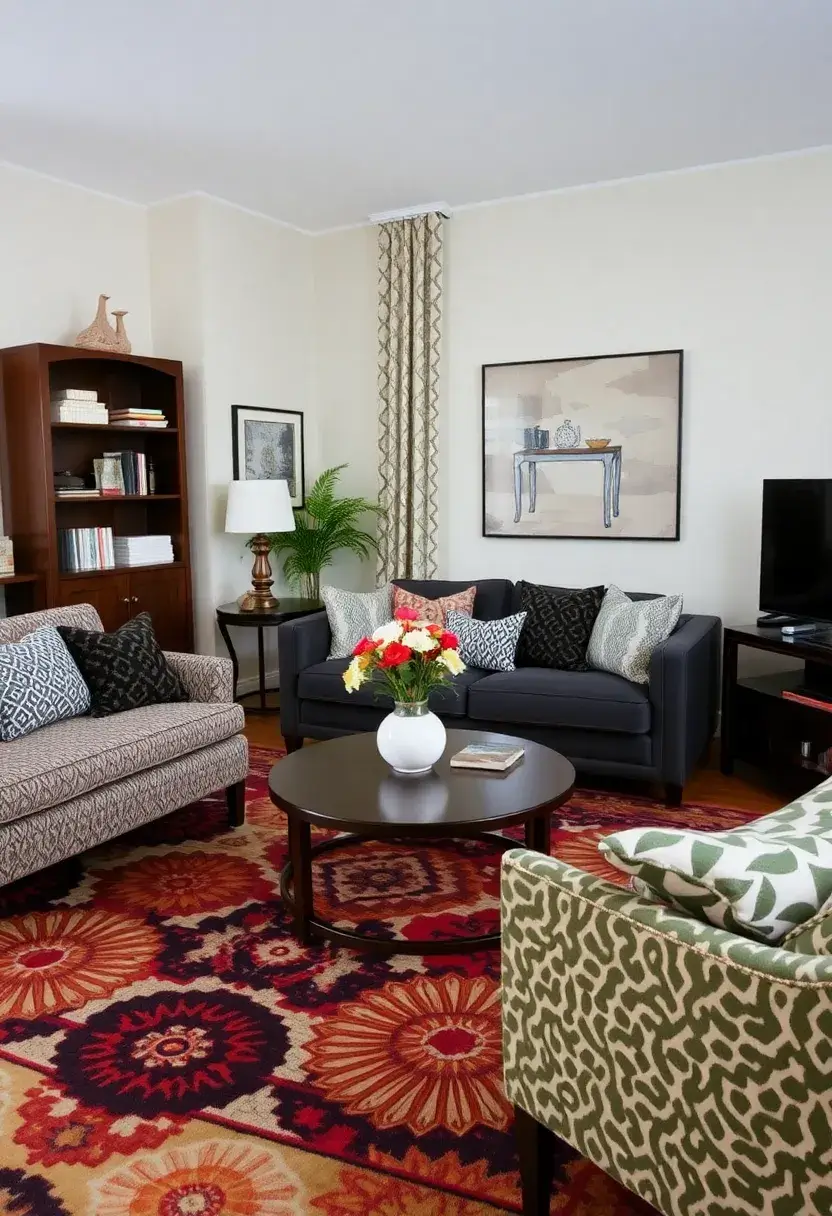
Patterns can elevate your retro living room’s design to new heights. From bold geometric prints to playful floral motifs, mixing patterns creates excitement. A striking patterned rug can serve as a foundation, allowing you to pull colors for pillows or curtains. If your space is neutral, patterns can add vibrancy and energy.
Don’t hesitate to mix styles; a graphic print can harmonize with a classic floral design. Just ensure your color palette remains cohesive to maintain an intentional look. This playful approach can transform your living room into a lively and inviting space.
• Use patterns in unexpected places like ceilings.
• Keep a few elements simple to avoid chaos.
• Choose a cohesive color palette for balance.
• Experiment with layering patterns for depth.
With these tips, your living room will reflect the vibrant essence of retro design.
Play with Patterns
Editor’s Choice

Mohawk Home Alliance Modern Geometric 6′ x 9′ Area Rug – Red – Perfect f…
 Amazon$105.32
Amazon$105.32
Multicolored Rainbow Abstract Throw Pillow Covers 18×18 in Set of 2, Dec…
 Amazon$9.99
Amazon$9.99
6 Pack 14” Modern Herringbone Geometric Brick Hexagon Boho Lines Wall S…
 Amazon$9.99
Amazon$9.996. Create a Gallery Wall of Nostalgic Art
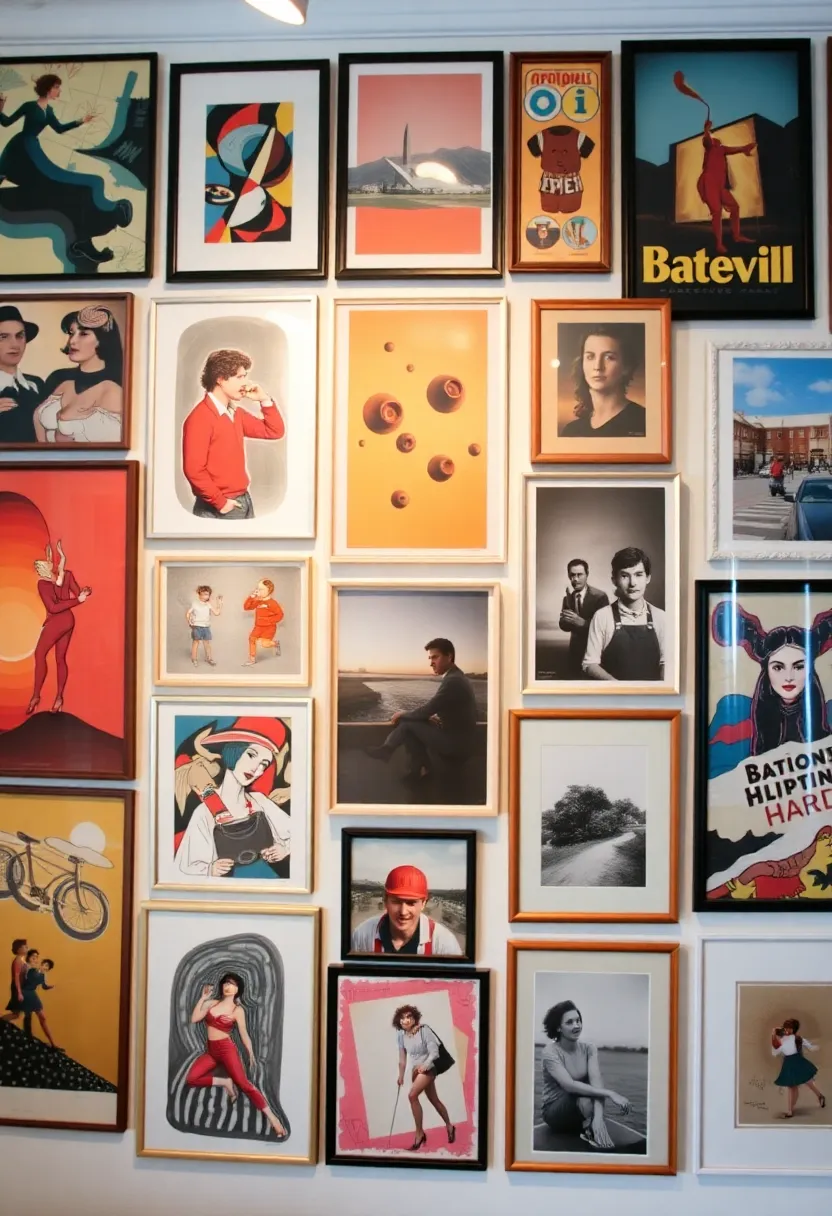
A gallery wall can be the perfect focal point in your retro living room. Collect art pieces that resonate with the era—think abstract prints, vintage posters, and iconic photographs. Arranging them in a cohesive layout tells a story while adding a personal touch to your space.
Mix different frame styles and sizes for visual interest; incorporating 3D elements like shelves for knick-knacks can enhance the display. Ensure the color palette complements your room’s decor for a harmonious look. This gallery wall allows you to express your personality while enhancing your living room’s nostalgic charm.
• Choose a diverse art collection for variety.
• Use a cohesive color palette for harmony.
• Incorporate 3D elements for creativity.
• Arrange pieces for a balanced look.
This artistic expression will make your living room feel unique and inviting.
Create a Gallery Wall of Nostalgic Art
Editor’s Choice

97 Decor Vintage Eclectic Wall Art Collage – Abstract Modern Art Prints …
 Amazon$9.99
Amazon$9.99
eletecpro 12×12 Picture Frames Set of 9 with Mat for 8×8 Photos or witho…
 Amazon$33.08
Amazon$33.08
BAYKA Floating Shelves for Wall, Wall Mounted Rustic Wood Shelves for Ba…
 Amazon$20.99
Amazon$20.997. Retro Lighting Fixtures to Set the Mood
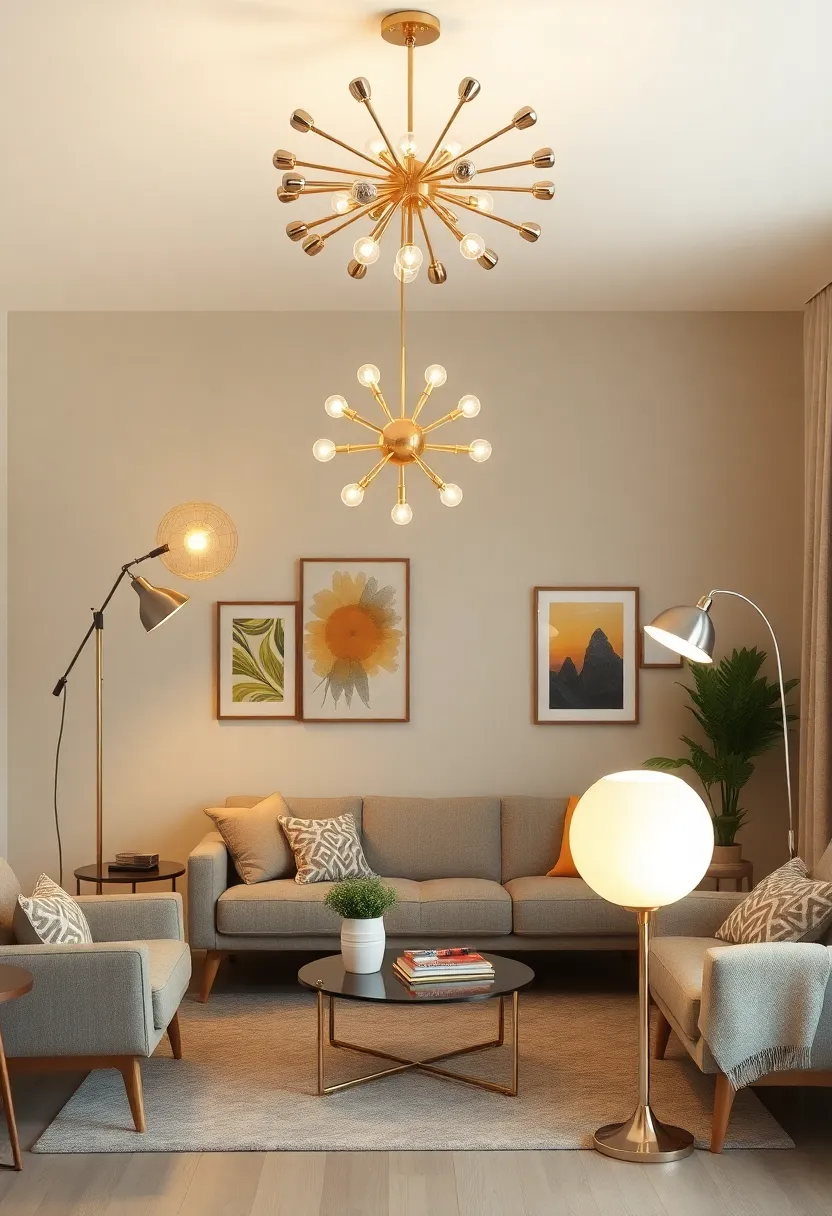
Lighting plays a crucial role in shaping the atmosphere of your retro living room. Look for striking lighting fixtures like Sputnik chandeliers or mid-century floor lamps to add nostalgic flair. A unique lamp can act as both a light source and a decorative piece.
Opt for warm light bulbs to create a cozy glow; dimmers can help set the perfect mood for gatherings or relaxation. Layering various light sources, like table lamps and overhead fixtures, adds depth to your room. This thoughtful lighting can make your living space feel welcoming and stylish.
• Choose statement fixtures for impact.
• Incorporate warm light bulbs for coziness.
• Layer different light sources for depth.
• Use string lights for charm.
With the right lighting, your living room becomes a perfect retreat for relaxation and fun.
Retro Lighting Fixtures to Set the Mood
Editor’s Choice

Modern Chandelier Ceiling Light Fixture Sputnik Chandeliers Gold and Bla…
 Amazon$50.94
Amazon$50.94
LEPOWER Wood Tripod Floor Lamp, Mid Century Standing Lamp, Modern Design…
 Amazon$50.37
Amazon$50.37
JMEXSUSS 100 LED Connectable Globe String Lights Indoor Bedroom, 33ft Wa…
 Amazon$15.99
Amazon$15.998. Classic Furniture Arrangements

The arrangement of your furniture can significantly influence the feel of your living room. Classic layouts often promote conversation and comfort—like placing sofas facing each other or creating a circular setup around a coffee table. This arrangement fosters an inviting atmosphere that encourages social interaction.
Ensure that pathways are clear and there’s ample room to move around. Creating cozy conversation nooks with side chairs or ottomans adds to the comfort. This strategic arrangement can enhance both the aesthetic and functionality of your space.
• Use rugs to define areas in your living room.
• Balance heavier and lighter furniture for harmony.
• Create nooks for conversation with comfortable seating.
• Ensure clear pathways for movement.
A well-planned arrangement will make your living room feel open and welcoming.
Classic Furniture Arrangements
Editor’s Choice

5×7 Area Rug Living Room Rug: Washable Modern Abstract Soft Thin Rug Ind…
 Amazon$26.99
Amazon$26.99
HIGOGOGO Round Stuffed Pouf Ottoman, Corduroy Poufs with Foam Chunk Fill…
 Amazon$39.99
Amazon$39.99
Yaheetech Accent Barrel Chair, Boucle Fabric Club Chair, Furry Sherpa El…
 Amazon$97.99
Amazon$97.999. Incorporate Plants for a Touch of Nature

Plants can bring life and color into your retro living room. Choose lush greenery like spider plants or snake plants that were popular in the mid-century era. Stylish plant stands or hanging planters can elevate your indoor garden, adding visual interest.
Mixing different plant sizes creates depth, with small succulents on the coffee table and larger floor plants in the corners. Decorative pots with retro patterns or colors enhance the overall look. This natural touch makes your space feel fresh and inviting.
• Group plants in odd numbers for a natural look.
• Use plants to soften hard edges in the room.
• Choose stylish pots that match your decor.
• Incorporate hanging plants for vertical interest.
By adding plants, your living room will feel cozy and connected to nature.
Incorporate Plants for a Touch of Nature
Editor’s Choice

Variegated Spider Plant – Extra-Large – Air-Purifying, Low Maintenance, …
 Amazon$15.98
Amazon$15.98
Gepege 6 Inch Beaded Ceramic Planter Set of 2 with Drainage Hole and Sau…
 Amazon$19.99
Amazon$19.99
5-Pack Decent Metal Plant Stands, Heavy Duty Flower Pot Stands for Multi…
 Amazon$19.99
Amazon$19.9910. Choose Statement Art Pieces
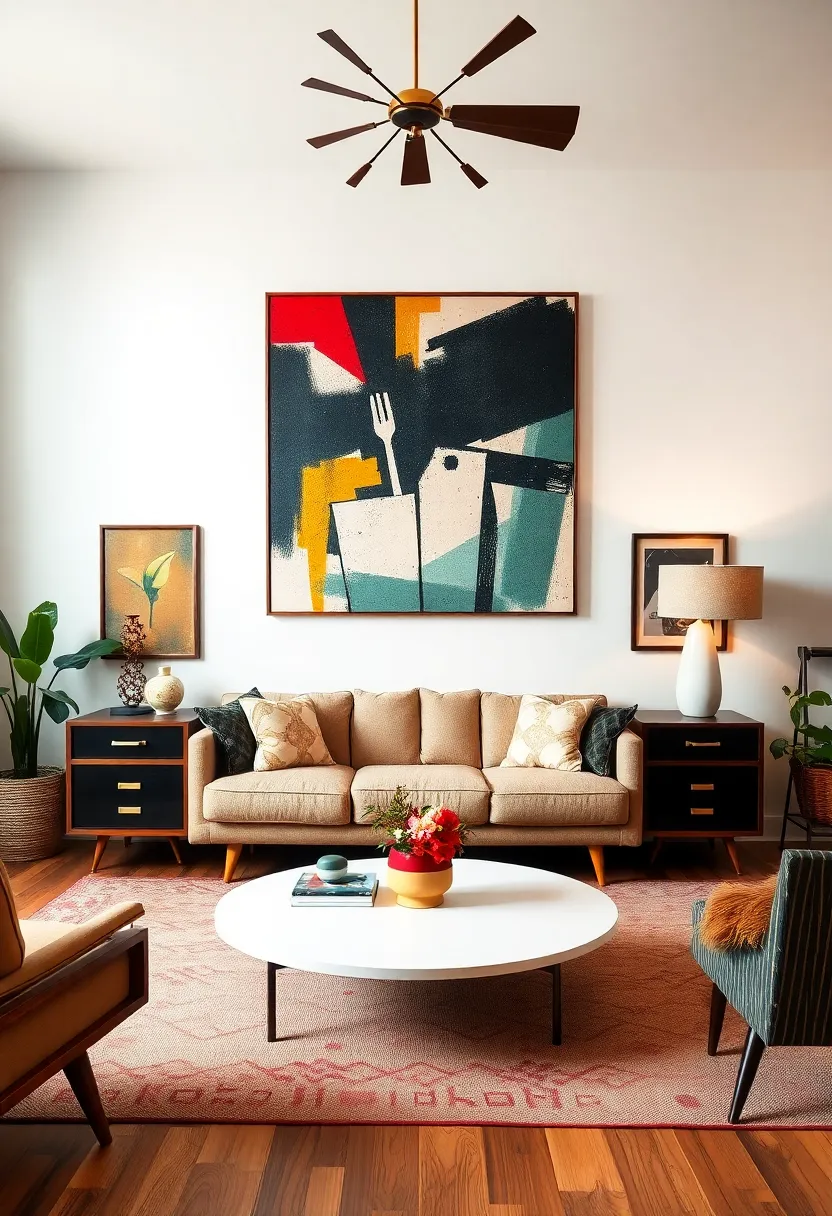
Statement art pieces can dramatically elevate your retro living room. Look for oversized wall art or bold sculptures that draw attention. These pieces not only create visual interest but also act as conversation starters.
Consider incorporating iconic artists from the mid-century era or vibrant pop art styles to capture the spirit of the time. When placing art, be mindful of your room’s layout; a large canvas above a sofa can serve as a stunning backdrop. This thoughtful placement enhances the overall design of your space.
• Mix various art styles for diversity.
• Maintain a coherent color scheme for unity.
• Don’t be afraid to go big with art for impact.
• Use art to fill gaps on shelves.
Thoughtfully incorporating art will give your living room a unique and stylish flair.
Choose Statement Art Pieces
Editor’s Choice
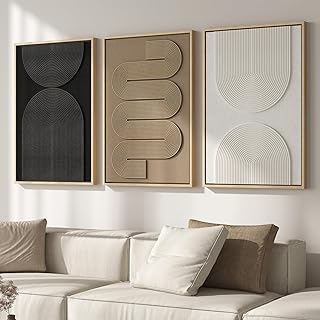
Large 3D Textured Framed Boho Neutral Abstract Wall Art for Living Room,…
 Amazon$259.99
Amazon$259.99
Wink – Handcrafted Statues Resin Abstract Sculpture for Home Decor Moder…
 Amazon$21.70
Amazon$21.70
97 Decor Vintage Eclectic Wall Art Collage – Abstract Modern Art Prints …
 Amazon$9.99
Amazon$9.9911. Revisit the Retro Television
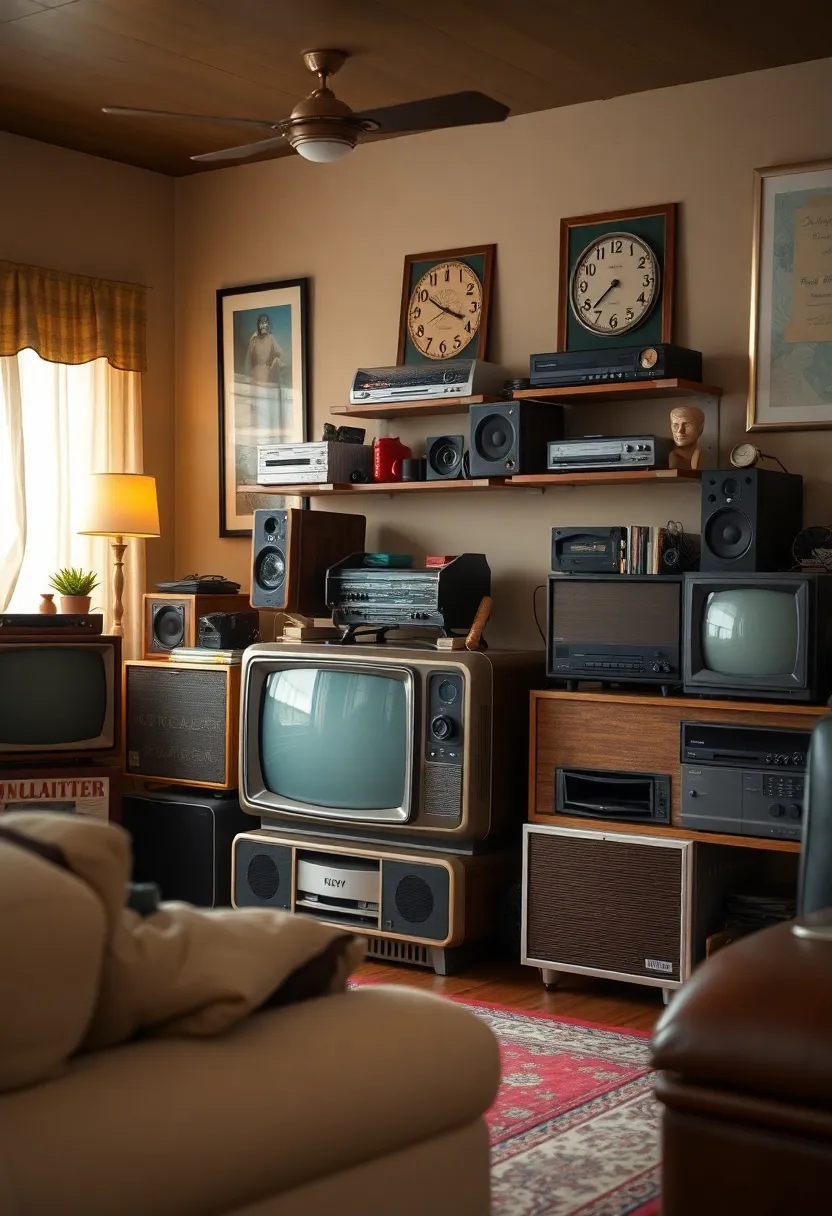
A vintage television can serve as a charming focal point in your living room. Seek out retro models with wooden cabinetry or bright colors from the 60s and 70s. Setting up a dedicated area for your retro TV evokes nostalgia, complete with vintage media like vinyl records.
Pair your TV with a media console that complements its style, enhancing the overall vintage aesthetic. This nostalgic touch can create a delightful space for entertainment and relaxation.
• Create a mini entertainment corner with comfy seating.
• Use a vintage TV tray for snacks during movie nights.
• Incorporate retro media for authenticity.
• Display matching decor to enhance the theme.
A retro television adds a fun and nostalgic element to your living room.
Revisit the Retro Television
Editor’s Choice

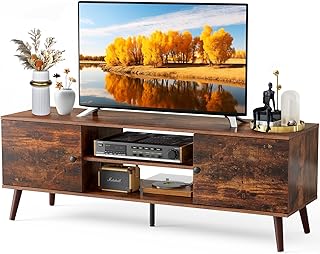
DUMOS TV Stand for 55 60 inch TV, Entertainment Center with Storage Cabi…
 AmazonCheck Price
AmazonCheck Price
HOOBRO Folding TV Tray Tables, Set of 2 Side Table for Small Space, Indu…
 Amazon$38.99
Amazon$38.9912. Use Vintage Books as Decor
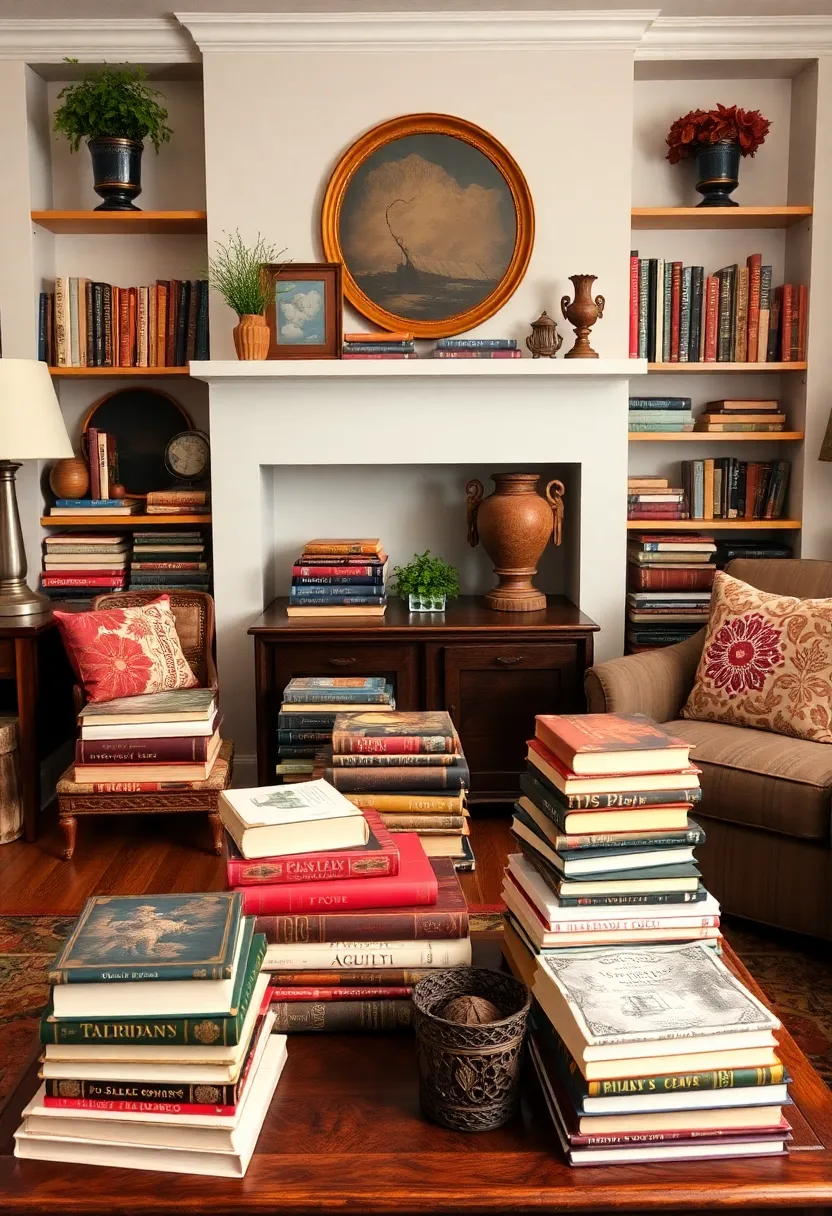
Vintage books can add charm and a cozy vibe to your retro living room. Stack colorful editions on your coffee table or display them on bookshelves. Look for books with interesting covers that enhance your decor. Pair them with decorative objects like an antique magnifying glass for added flair.
You might also use a vintage suitcase or wooden crate to store your favorite reads, creating a stylish storage solution. This personal touch can make your living room feel warm and inviting.
• Arrange books by color for visual appeal.
• Use books to fill empty spaces creatively.
• Incorporate unique bookends to enhance the display.
• Consider vintage editions for authenticity.
Vintage books will not only serve as decor but also tell a story in your living space.
Use Vintage Books as Decor
Editor’s Choice

Disney Classic Storybook Collection for Toddlers Kids ~ 8 Disney Books B…
 Amazon$21.99
Amazon$21.99
Hiceeden 10X Antique Magnifying Glass, Brass Handheld Magnifier with Woo…
 Amazon$14.99
Amazon$14.99
Bookends Decorative Metal Unique Office Desk Bookends Cute Book Ends Rea…
 Amazon$17.99
Amazon$17.9913. Add a Touch of Glam with Metallic Accents

Metallic accents can infuse a touch of glam into your retro living room. Brass, gold, and chrome finishes were popular in mid-century designs and can elevate the overall aesthetic. Consider adding metallic lamps, mirrors, or decorative accents that catch the light beautifully.
Balance metallics with other materials like wood or fabric to create a harmonious look. This combination can add sophistication without overwhelming the space.
• Choose a consistent metallic finish for unity.
• Use reflective surfaces to enhance light.
• Incorporate metallic decor subtly for elegance.
• Mix with natural materials for balance.
Adding metallic accents will bring a delightful sparkle to your living room.
Add a Touch of Glam with Metallic Accents
Editor’s Choice

Kenroy Home 30437AB Spyglass Table Lamp with Antique Brass Finish, Class…
 Amazon$92.79
Amazon$92.79
MIMOSA MOMENTS Metallic Picture Frame, Brushed Satin Finish,8 x 10 Photo…
 Amazon$18.71
Amazon$18.71
Acrylic Coffee Table for Living Room Clear Rectangle Lucite Table with O…
 Amazon$199.00
Amazon$199.0014. Opt for Unique Shelving Solutions
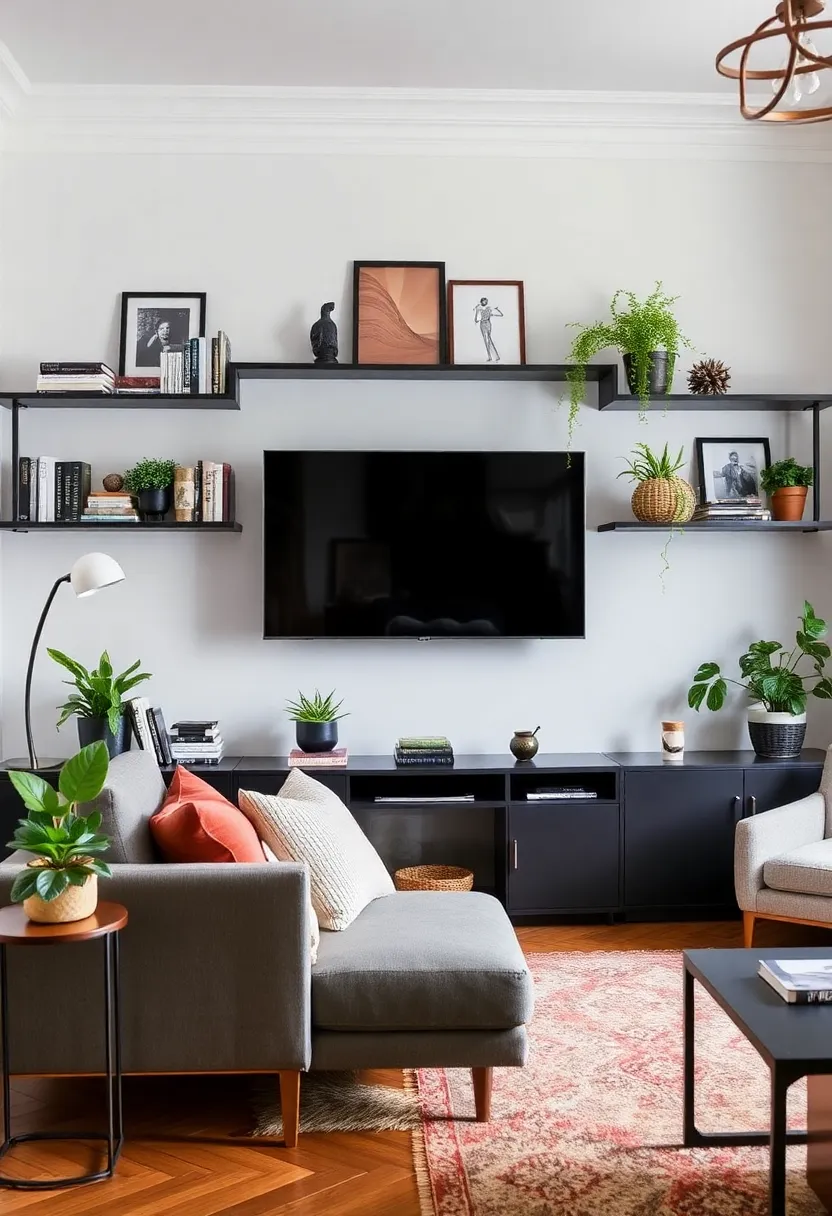
Shelving can be a key design element in your retro living room. Consider open shelving units that display your favorite decor pieces or plants. Geometric shelving or vintage bookcases can add visual interest and provide functional storage.
Mixing in vintage boxes or baskets creates a charming touch. This approach allows you to showcase your style while keeping things organized.
• Create a mini gallery with frames and art pieces on shelves.
• Experiment with different heights for dynamic appeal.
• Use decorative storage for functionality.
• Incorporate plants on shelves for freshness.
Unique shelving solutions can add depth and personality to your living space.
Opt for open shelving to create a personal gallery—display favorite decor, plants, and a mini art lineup, while keeping clutter in check. With geometric shelving and vintage bookcases, storage becomes style, not a trade-off—proof that ideas for retro living room can be practical and chic.
Opt for Unique Shelving Solutions
Editor’s Choice

REGILLER 6 Wire Shelving Steel Storage Rack Adjustable Unit Shelves for …
 Amazon$36.99
Amazon$36.99
VASAGLE Bookcase, 5-Tier Bookshelf, Display Shelf and Room Divider, Free…
 Amazon$52.99
Amazon$52.99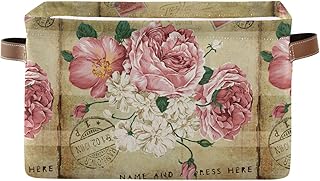
ALAZA Vintage Shabby Chic Rose Floral Foldable Storage Box Storage Baske…
 Amazon$20.99
Amazon$20.9915. Don’t Forget the Throw Blankets
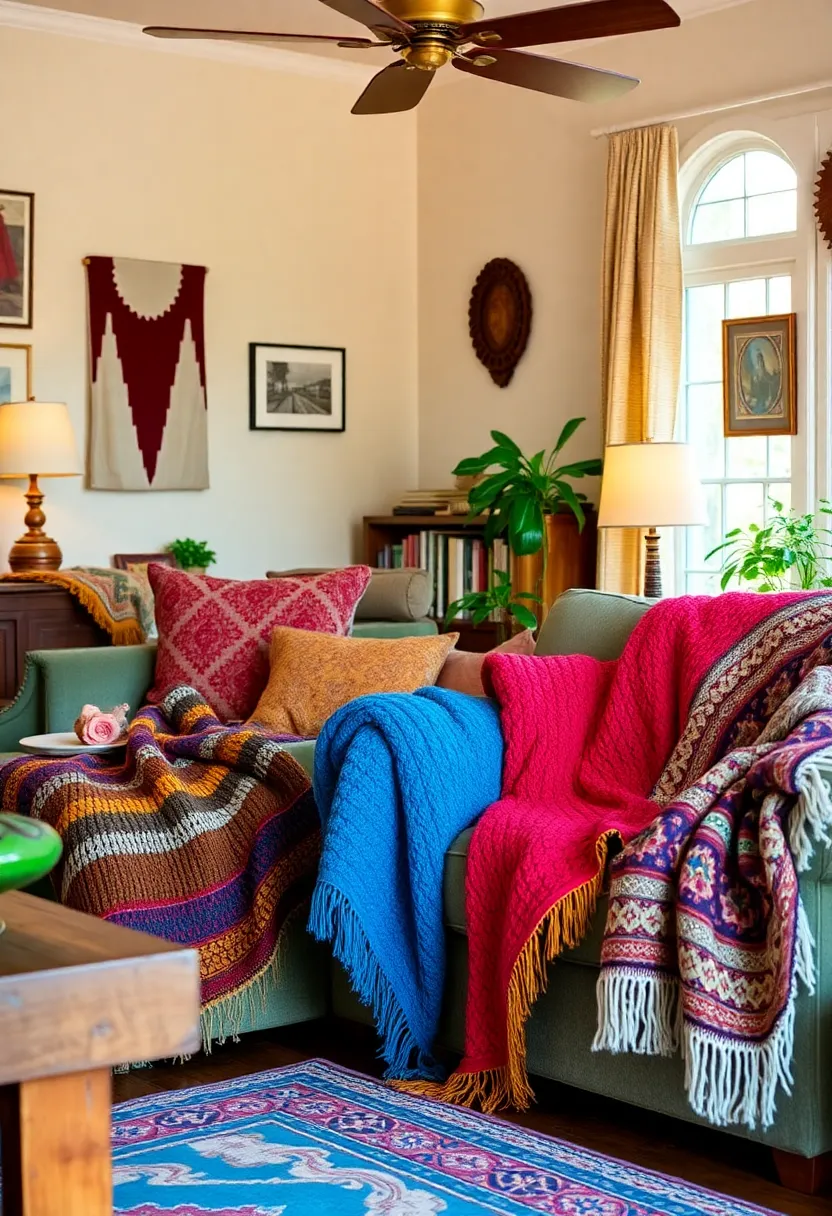
Throw blankets add warmth and a splash of color to your retro living room. Choose blankets with fun patterns that echo mid-century styles, like geometric designs or bold colors. Drape them over sofas or chairs for a cozy and chic look.
When selecting throw blankets, consider varying materials; a knitted throw can contrast beautifully with a smooth fabric sofa. This layering invites comfort and style into your space.
• Layer throws with different textures for visual interest.
• Use basket storage for easy access.
• Choose throws that reflect your color scheme.
• Mix and match patterns for fun.
Adding throw blankets creates a welcoming environment, perfect for snuggling up on chilly evenings.
Don’t Forget the Throw Blankets
Editor’s Choice

Mid Century Retro Throw Blanket Soft Cozy Plush Warm Fleece Blanket for …
 Amazon$27.99
Amazon$27.99
Admitrack Chunky Knit Blanket Throw 51″x63″, 100% Hand Knit Chenille Thr…
 Amazon$34.99
Amazon$34.99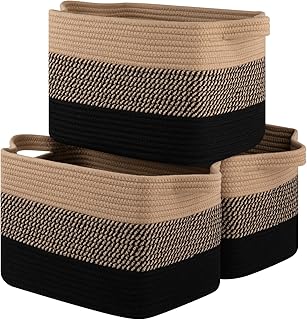
Storage Basket for Organizing, Woven Baskets for Storage, Rectangle Deco…
 Amazon$25.64
Amazon$25.6416. Vintage Rugs for Character

Rugs can significantly impact the vibe of your living room, especially in retro styles. Search for vintage Persian or shag rugs that bring warmth and nostalgia to your space. A bold, patterned rug serves as a dramatic foundation for your furniture arrangement.
Layering rugs can create an eclectic look; try placing a smaller patterned rug atop a larger solid one for texture. Be mindful of size to ensure it complements your seating arrangement without overwhelming the room.
• Choose a rug that reflects your personality.
• Use a rug pad for comfort and stability.
• Mix different styles for an eclectic touch.
• Opt for easy-to-clean materials for practicality.
The right rug can enhance your living room’s charm, making it feel warm and inviting.
Vintage Rugs for Character
Editor’s Choice

SAFAVIEH Vintage Hamadan Collection Area Rug – 8′ x 10′, Red & Multi, Or…
 Amazon$215.00
Amazon$215.00
Shag Area Rugs for Bedroom Living Room,5X8 Ultra Soft Fluffy Area Rugs f…
 Amazon$24.68
Amazon$24.68
BAGAIL Felt and Natural Rubber Backing Rug Pads 1/4” Thick, 5 x 7 Ft Non…
 Amazon$37.99
Amazon$37.9917. Retro Bar Cart for Entertaining

A bar cart adds both style and functionality to your retro living room. Look for a vintage cart with classic design features to display your favorite spirits and glassware. Arrange colorful bottles and decorative items for a chic display.
This cart can also serve as a mobile serving station when entertaining guests, adding a playful touch to your space. Keeping it organized with coasters and trays enhances its usability.
• Use a tiered tray for stylish display.
• Incorporate plants or art pieces for flair.
• Choose colorful glassware to complement your theme.
• Keep essentials easy to access for convenience.
A retro bar cart can spark joy and create a fun atmosphere for gatherings.
Retro Bar Cart for Entertaining
Editor’s Choice


Coasters Set of 8,Cork Coasters for Drinks,Colorful Drink Coaster with H…
 Amazon$9.99
Amazon$9.99
Nearly Natural 48in Dracaena Silk Plant (Real Touch) Green
 Amazon$37.00
Amazon$37.0018. Quirky Collectibles as Decor
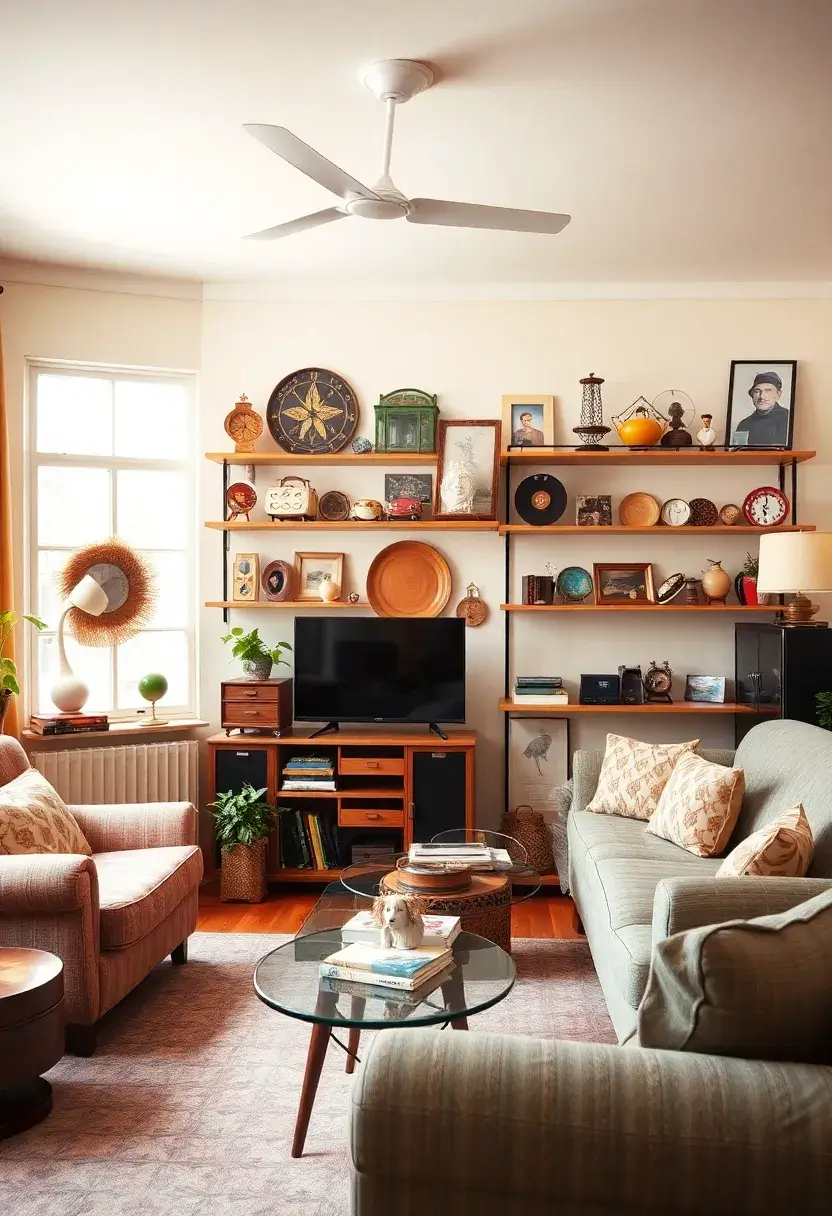
Quirky collectibles can add a personal touch and nostalgia to your living room. Display vintage toys, classic vinyl records, or unique ceramics that reflect your interests. Use open shelving to showcase these items without cluttering the space.
The key is to curate a collection that feels cohesive and fun, allowing your personality to shine. Grouping similar items together enhances visual impact while contrasting backgrounds can make them pop.
• Use shadow boxes for unique items.
• Incorporate lighting to highlight collectibles.
• Keep the collection curated and cohesive.
• Display items in unexpected ways for creativity.
These collectibles can tell a story and create a delightful atmosphere in your living room.
Quirky Collectibles as Decor
Editor’s Choice

REGILLER 6 Wire Shelving Steel Storage Rack Adjustable Unit Shelves for …
 Amazon$36.99
Amazon$36.99
Americanflat 11×14 Shadow Box Frame – Soft Linen Back – Perfect to Displ…
 Amazon$24.75
Amazon$24.75
Deco 79 Wooden Decorative Trunk Vintage Studded Woven Storage Decorative…
 Amazon$59.93
Amazon$59.9319. Experiment with Upholstery

Upholstery can greatly influence the feel of your retro living room. Consider reupholstering furniture in bold fabrics like floral prints or luxurious velvet to capture the mid-century vibe. Mixing different upholstery styles can create an eclectic look that feels curated and unique.
A vibrant accent chair can add a playful pop against more muted furniture. When choosing fabrics, prioritize durability and ease of cleaning, especially for frequently used pieces.
• Incorporate unexpected textures like leather for contrast.
• Use fabric swatches to test combinations.
• Consider classic patterns for timeless appeal.
• Experiment with bold colors for impact.
By exploring upholstery options, you can elevate your space while celebrating retro design.
Experiment with Upholstery
Editor’s Choice
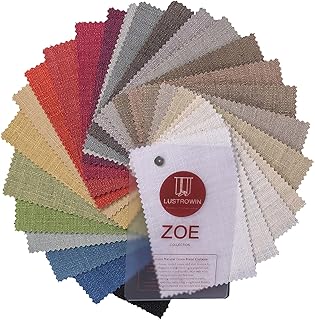
LUSTROWIN Natural Linen Blend Fabric Sample Booklet, 27 Colors Available
 Amazon$6.99
Amazon$6.99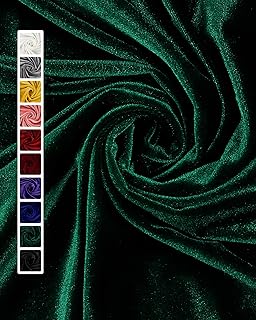
HOTGODEN Stretch Velvet Fabric by The Yard: Hunter Green 63″ Wide 1 Yard…
 Amazon$9.99
Amazon$9.99
Leather Repair Patch Tape Kit, Self Adhesive Leather Repair for Furnitur…
 Amazon$7.98
Amazon$7.9820. Use Vintage Mirrors to Reflect Style
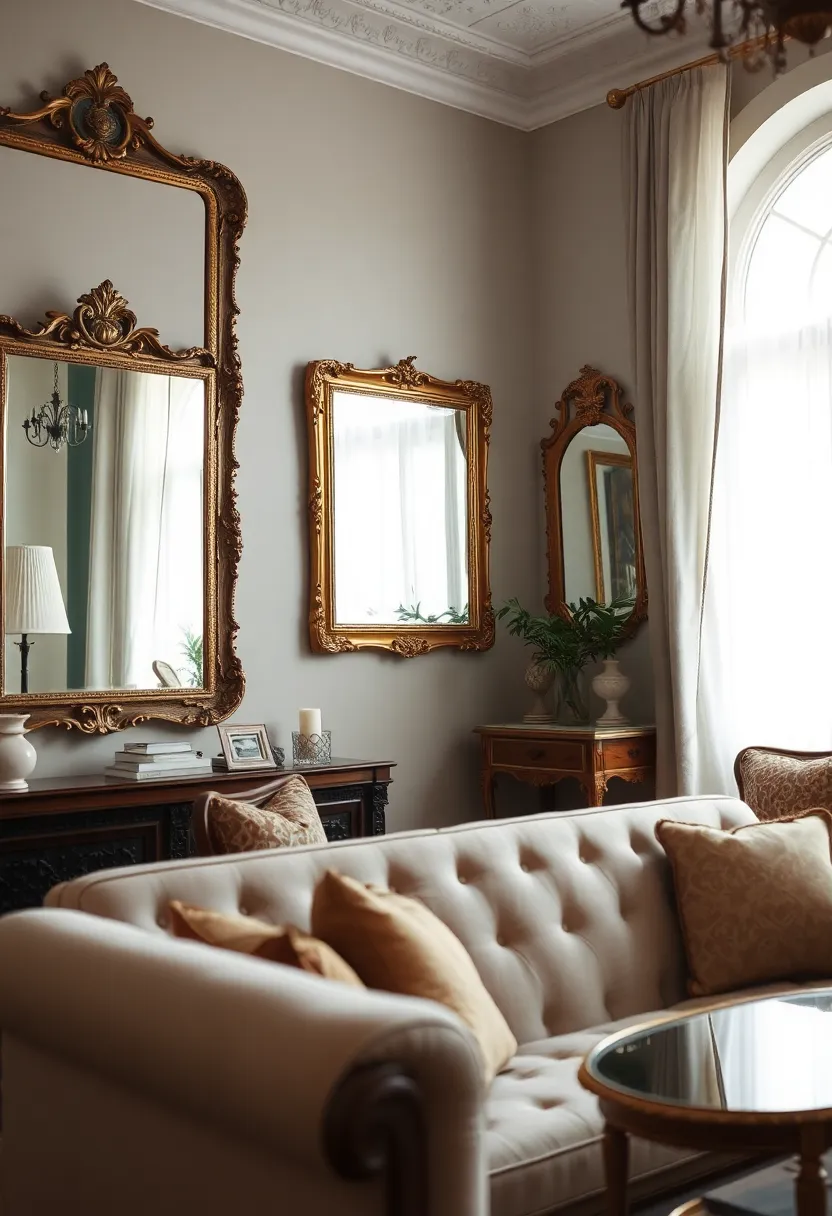
Mirrors can amplify space and light in your retro living room. Seek vintage mirrors with ornate or geometric frames that reflect the era’s charm. A large statement mirror can serve as an eye-catching focal point while making the room feel larger and brighter.
Grouping smaller mirrors can create an interesting gallery wall effect. Be mindful of placement; mirrors near windows can enhance natural light. This thoughtful addition can invigorate your living space.
• Use mirrors to complement your color palette.
• Choose styles that align with your theme.
• Incorporate mirrors in unexpected places.
• Consider varied sizes for visual interest.
Vintage mirrors can brighten your living room while adding a touch of whimsy.
Use Vintage Mirrors to Reflect Style
Editor’s Choice

OIGUMR Oval Smallest Wall Mirror Resin Frame Size:12 x 8.3 inch Mirror V…
 Amazon$19.99
Amazon$19.99
PERFNIQUE Irregular Wall Mirror Asymmetrical Mirror, 32”x24” Gold Mirr…
 Amazon$65.98
Amazon$65.98
Light In The Dark Medium Round Mirror Wall Mounted Assorted Sizes (1×10”…
 Amazon$11.99
Amazon$11.9921. Nostalgic Wall Treatments
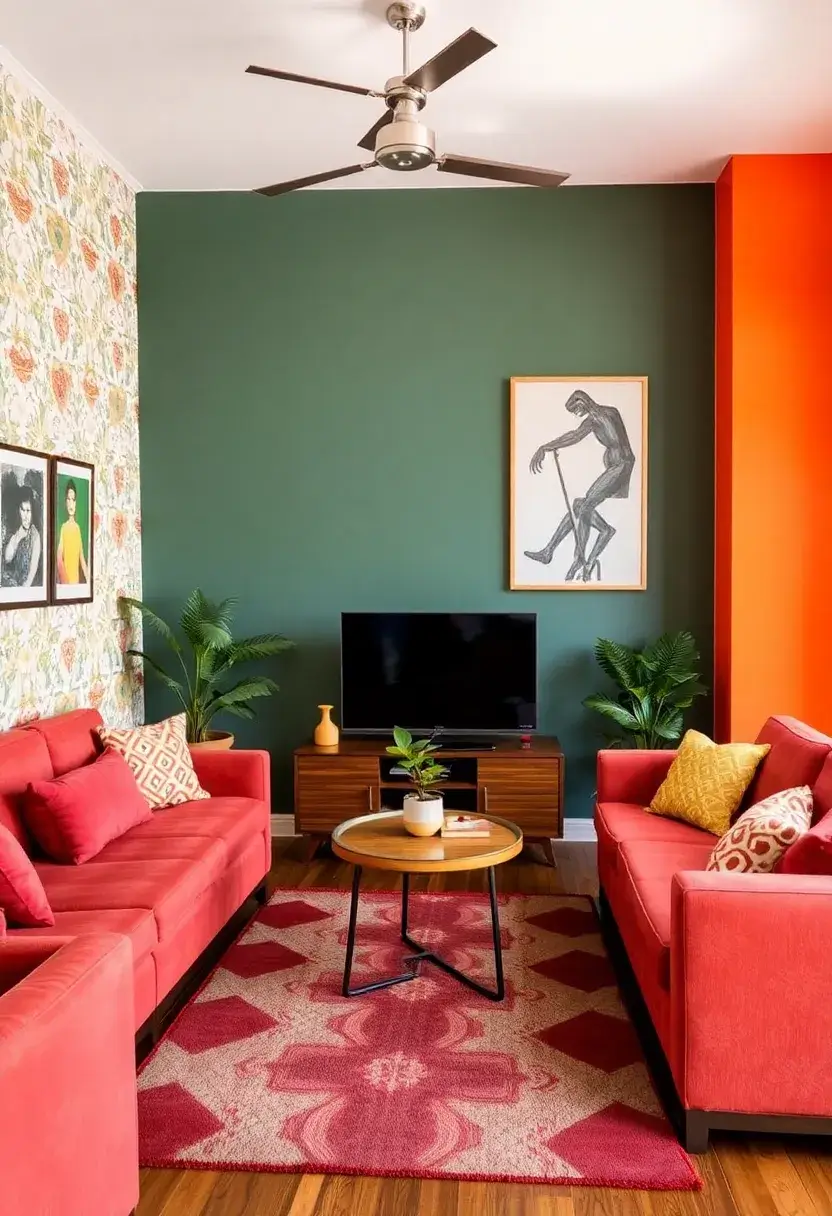
Wall treatments can completely transform your living room’s look. Consider wallpaper with retro patterns or textures like grasscloth for an authentic feel. If wallpaper isn’t your style, painted accent walls or wood paneling can evoke nostalgia. Be playful with your choices to make a statement.
When applying wallpaper or paint, think about how it interacts with your furniture and decor. This approach ensures a cohesive look that resonates with your personality.
• Choose a treatment that reflects your style and personality.
• Don’t hesitate to mix patterns for uniqueness.
• Consider bold colors to make a statement.
• Keep balance in mind with surrounding decor.
Nostalgic wall treatments can add depth and character to your living space.
Nostalgic Wall Treatments
Editor’s Choice

JiffDiff Retro Checkered Wallpaper Peel and Stick 15.7″x 118″ Retro Geom…
 Amazon$12.99
Amazon$12.99
Beige Faux Grasscloth Wallpaper Peel and Stick Linen Textured 24″x394″ U…
 Amazon$43.99
Amazon$43.99
Rust-Oleum 1990502 Painter’s Touch Latex Paint, Quart, Flat White 32 Fl …
 Amazon$16.98
Amazon$16.9822. Feature a Stylish Coffee Table
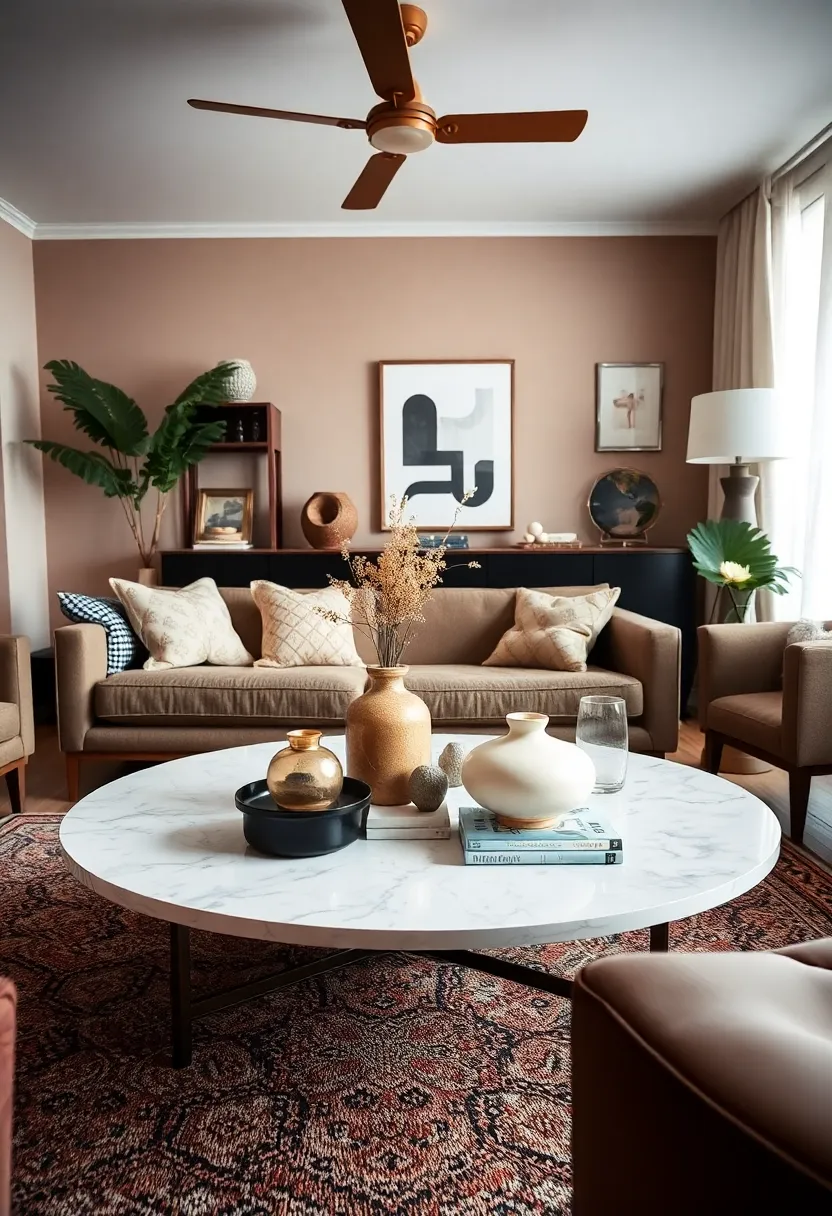
A coffee table often serves as the centerpiece of a living room, so it deserves special attention. Choose a table that embodies retro charm, such as unique shapes like oval or kidney designs. A glass top can create an airy feel, while a wooden table can add warmth and character.
Accessorize your coffee table with decorative books, fresh flowers, or a unique centerpiece that reflects your style. Keep height and proportions in mind when arranging decor to maintain functionality without clutter.
• Use coasters to protect surfaces.
• Group decorative items in odd numbers for visual appeal.
• Incorporate seasonal decor for freshness.
• Ensure the table complements your overall design aesthetic.
A stylish coffee table enhances the overall aesthetic of your living room while serving practical purposes.
Feature a Stylish Coffee Table
Editor’s Choice

WLIVE Lift Top Coffee Table for Living Room,Small Coffee Table with Stor…
 Amazon$69.98
Amazon$69.98

ABenkle 8 Pcs Drink Coasters with Holder, Cotton Woven Absorbent Coaster…
 Amazon$9.99
Amazon$9.9923. Incorporate Fun Barware
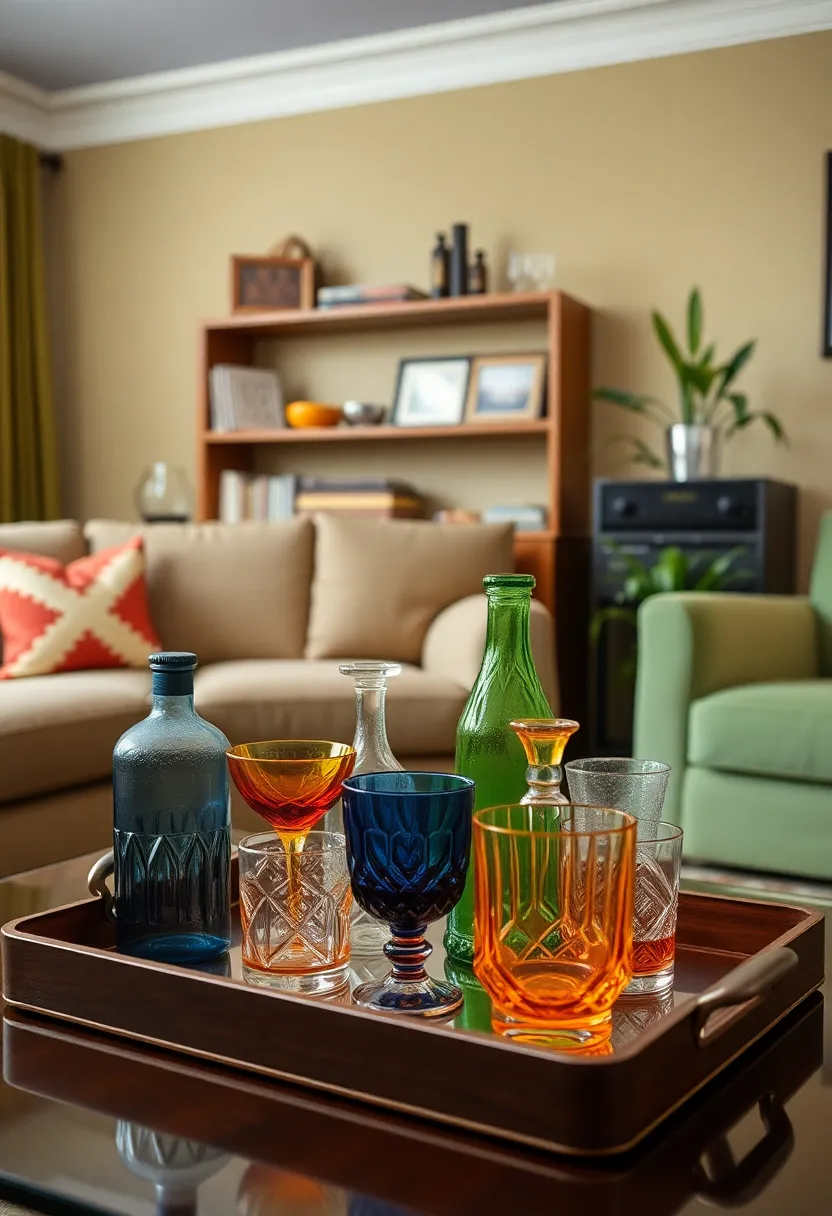
Fun barware adds a playful touch to your retro living room, making it ideal for entertaining. Seek out colorful glassware, vintage cocktail shakers, and quirky coasters that double as decor. Set up a small bar area with your favorite spirits and tonic waters, along with fun recipe cards.
Balance function and style by displaying barware prominently while keeping it organized for easy access. This setup encourages hosting and invites creativity in your gatherings.
• Use a tiered tray for stylish organization.
• Choose colors that complement your overall theme.
• Incorporate fun cocktail recipes for guests.
• Keep essentials easily accessible for convenience.
Adding fun barware creates an inviting atmosphere for gatherings and celebrations.
Fun fact: Colorful glassware and vintage cocktail shakers can boost entertaining vibes in a retro living room by about 30%. Display a tidy bar area with recipe cards to invite guests to mix ideas for retro living room gatherings. Keep it organized for easy access and stylish flair.
Incorporate Fun Barware
Editor’s Choice

Mfacoy Colored Hobnail Drinking Glasses Set of 6, 12oz Vintage Kitchen G…
 Amazon$19.99
Amazon$19.99
Crystal Glass Cocktail & Vintage Shaker, 18.5oz Cutting Design – Exquisi…
 Amazon$17.99
Amazon$17.99
Mfacoy 3 Tier Serving Tray Set, 12″ Tiered Serving Trays Platters, Reusa…
 Amazon$20.99
Amazon$20.9924. Nostalgic Board Games for Entertainment
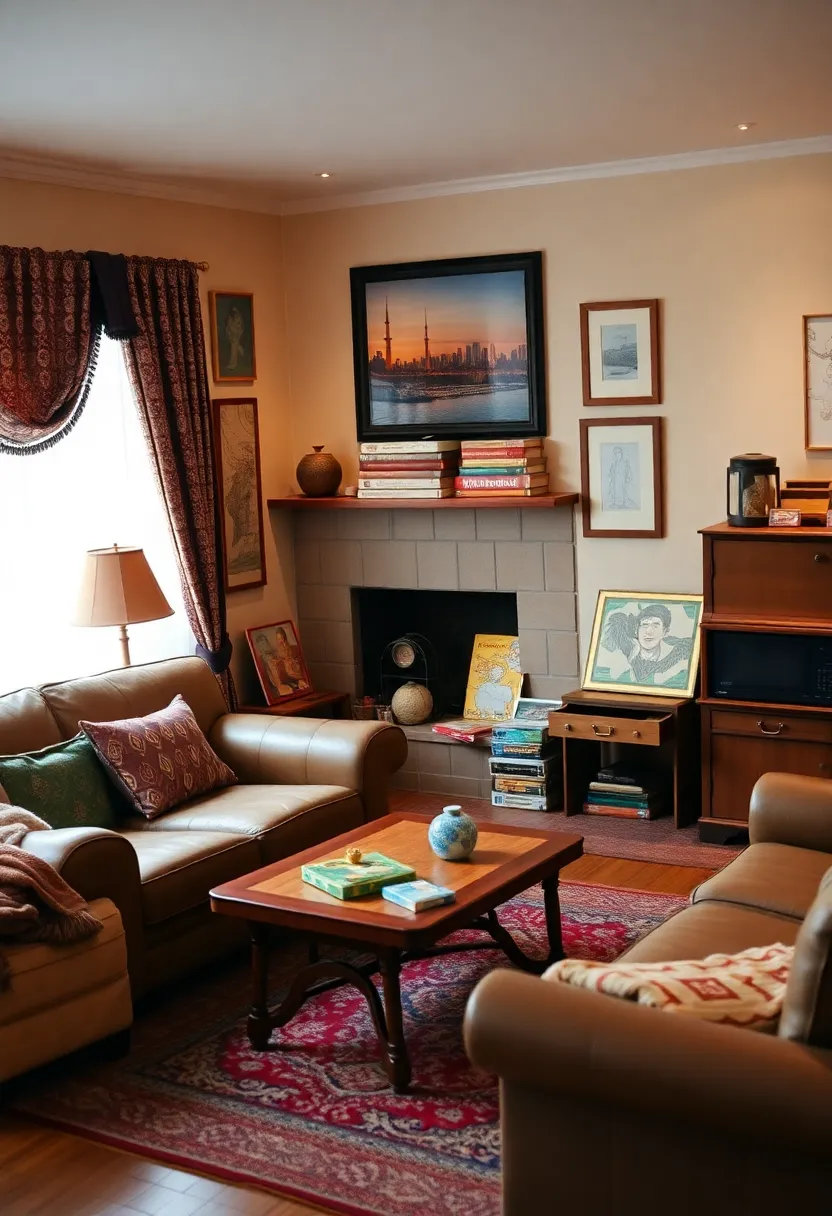
Nostalgic board games can add fun and interaction to your living room. Display classic games in an attractive way, perhaps in a decorative basket or on a stylish shelf. These games serve not only as decor but also invite fun gatherings with family and friends.
Choose games that reflect your interests; they can become conversation starters and enhance your retro theme. Consider creating a game table for dedicated game nights or using vintage game covers as art pieces.
• Use a decorative basket for stylish storage.
• Incorporate a game table for dedicated play.
• Display game covers as wall art for interest.
• Choose games that spark memories with loved ones.
Nostalgic board games can create joy and lasting memories in your living space.
Nostalgic Board Games for Entertainment
Editor’s Choice

WS Game Company Scrabble, Monopoly, and Clue Vintage Board Games Bookshe…
 Amazon$137.99
Amazon$137.99
Board Game Table with Removable Table Top, Seats 4 to 6 Players with 57i…
 Amazon$599.00
Amazon$599.00
Board Games Patent Wall Art Prints – Set of 6 Vintage Family Board Games…
 Amazon$16.95
Amazon$16.9525. Personalize with Family Photos

Family photos can add warmth and a personal touch to your retro living room. Using vintage-style frames enhances the nostalgic feel while showcasing special moments with loved ones. Consider creating a dedicated photo wall or integrating them into your gallery wall for a cohesive look.
Think about balance when arranging photos; using different frame sizes and orientations adds visual interest. This personal touch creates a comforting atmosphere filled with cherished memories.
• Choose a color scheme that complements your decor.
• Include candid shots for a laid-back feel.
• Mix black and white with color photos for contrast.
• Arrange photos in a balanced layout for harmony.
Personalizing your space with family photos creates a nurturing and welcoming environment.
Personalize with Family Photos
Editor’s Choice

3 Pcs Vintage Picture Frames Baroque Ornate Gold Arched Photo Frames Ant…
 Amazon$39.99
Amazon$39.99
Gallery Perfect 12-Piece Black Photo Frame Set with Hanging Template – 1…
 Amazon$80.99
Amazon$80.99
KBKBART 50Pcs Downtown Girl Room Decor, Y2k Wall Art Prints for Bedroom,…
 Amazon$9.99
Amazon$9.9926. Bring In Fun Patterns with Curtains
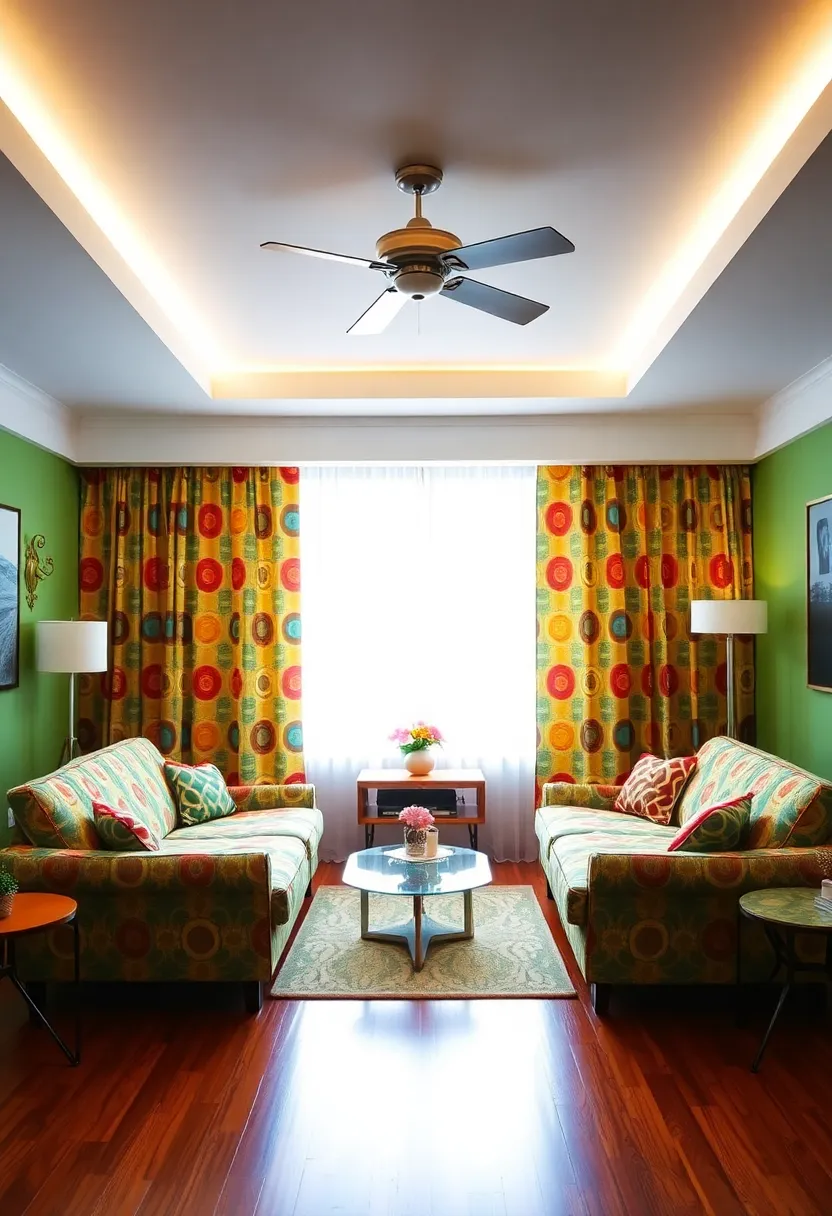
Curtains can significantly impact your retro living room’s look, offering both privacy and style. Choose curtains with fun patterns or bold colors that echo mid-century design. Geometric prints or large florals can add visual interest and enhance your overall aesthetic.
Consider the fabric as well; lightweight materials create a breezy feel, while heavier drapes add warmth and elegance. Hang curtains higher than the window frame to create an illusion of height, and opt for floor-length styles for added drama.
• Choose fun patterns to enhance the atmosphere.
• Use lightweight fabrics for a breezy feel.
• Hang curtains higher for a dramatic effect.
• Consider layering curtains for depth.
Fun curtains can enhance your living room while adding a playful touch of nostalgia.
Bring In Fun Patterns with Curtains
Editor’s Choice

jinchan 80% Blackout Curtains for Living Room, Geometric Patterns Drapes…
 Amazon$38.99
Amazon$38.99
OWENIE Sheer Curtains 84 inches Long 2 Panels Set for Living Room/Bedroo…
 Amazon$7.93
Amazon$7.93
NICETOWN Natural Linen Curtains 84 inch Long 2 Panels Set, Grommet Top T…
 Amazon$15.96
Amazon$15.9627. Use Unique Vintage Finds

Incorporating unique vintage finds can add character and soul to your living room. Look for unusual treasures like antique clocks, vintage globes, or retro signage that spark curiosity. These items can serve as focal points that enhance the overall theme of your space.
Create a curated display on a shelf or side table to showcase these finds beautifully. This approach allows your personality to shine while maintaining a cohesive look.
• Use vintage boxes or containers for stylish organization.
• Mix different styles to create harmony.
• Choose finds that resonate with your interests.
• Keep the overall aesthetic balanced by avoiding clutter.
Unique vintage finds can reflect your personal style and tell a story in your living space.
Use Unique Vintage Finds
Editor’s Choice

Wall Clock, Vintage Wall Clocks Battery Operated Quartz Silent Non-Ticki…
 Amazon$11.99
Amazon$11.99
Illuminated World Globe for Adults & Kids with Wooden Stand,Built in LED…
 Amazon$34.99
Amazon$34.99
ERLOOD Made in America Retro Metal Vintage Tin Sign 12 x 8
 Amazon$8.99
Amazon$8.9928. Create a Cozy Reading Nook
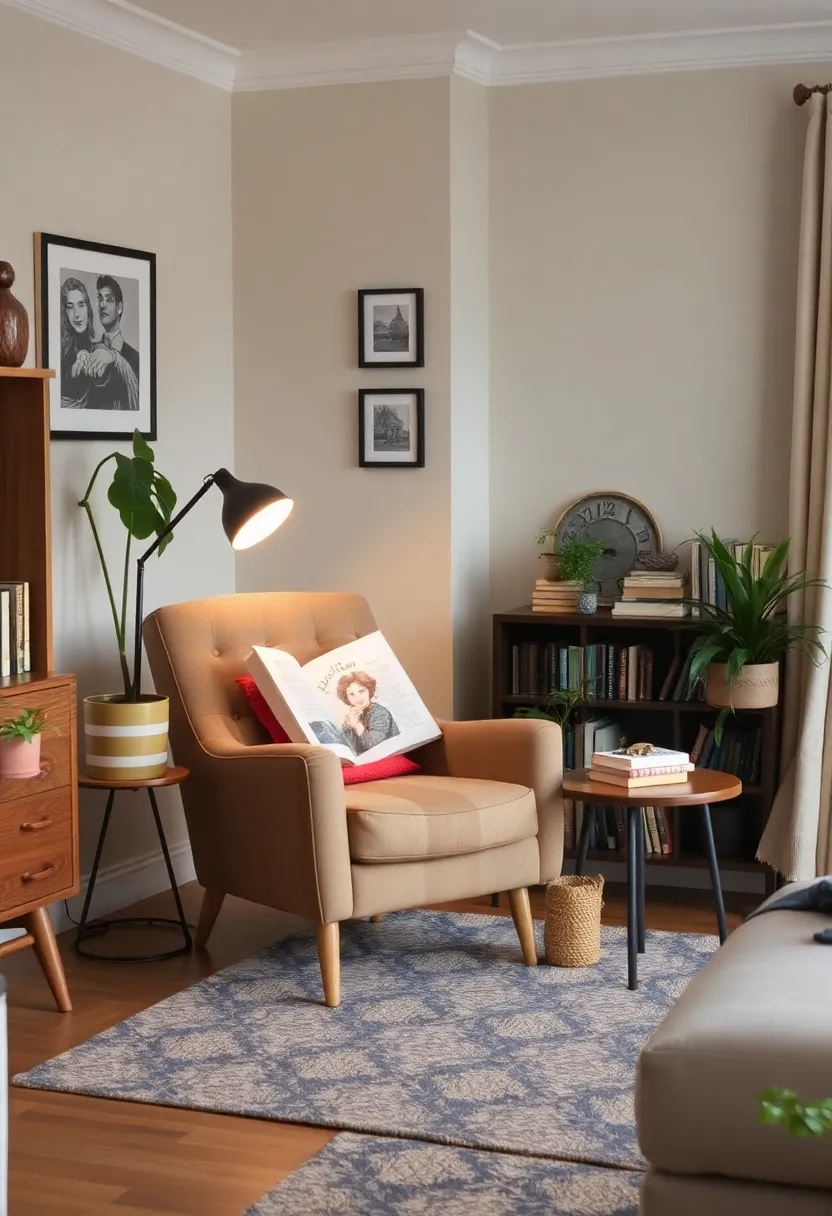
A cozy reading nook can be a lovely addition to your retro living room, offering a dedicated space for relaxation. Choose a comfortable chair in a vibrant pattern or color, paired with a small side table for your books and a warm throw blanket. Place it near a window for natural light or under a stylish floor lamp to create a cozy ambiance.
Surround the nook with bookshelves or vintage art to enhance its inviting vibe. Incorporating a small plant adds freshness to the space.
• Ensure the nook feels cozy with plush cushions.
• Use soft lighting to create a warm atmosphere.
• Personalize the space with decor that reflects your reading preferences.
• Keep it organized with functional storage.
A cozy reading nook can make your living room a perfect retreat for diving into your favorite books.
Create a Cozy Reading Nook
Editor’s Choice

Joysoul Living Room Accent Chair Modern High Back Arm Chair, Houndstooth…
 Amazon$119.69
Amazon$119.69
Bedsure GentleSoft White Throw Blanket for Couch – Cozy Blanket for Wome…
 Amazon$12.34
Amazon$12.34
Dimmable LED Lamps for Living Room with 3 Color Temperatures, Ultra Brig…
 Amazon$79.98
Amazon$79.9829. Combine Old and New

Mixing old and new elements can create a dynamic retro living room. Incorporate contemporary pieces alongside vintage finds for a balanced look. For instance, pair a modern coffee table with an antique sofa or use contemporary art in traditional frames. This contrast adds visual interest and depth.
Keep the color palette cohesive to tie everything together. This thoughtful combination can breathe new life into your living space while celebrating both eras.
• Use modern lighting fixtures with vintage furniture.
• Integrate updated technology into a retro aesthetic.
• Balance styles to create a harmonious look.
• Experiment with textures and colors for cohesion.
Combining old and new elements can create a beautifully engaging living space.
Combine Old and New
Editor’s Choice

Modern Glass Coffee Table for Living Room mid Century, Small Coffee Tabl…
 Amazon$149.99
Amazon$149.99
Vintage Pendant Light Fixtures: Glass Pendant Lights Kitchen Island, Gre…
 Amazon$39.99
Amazon$39.99
3D Textured Framed Abstract Wall Art, 3 Piece Modern Paintings Artwork f…
 Amazon$159.99
Amazon$159.9930. Fun DIY Projects to Add Character

DIY projects can add a unique, personal touch to your retro living room. Consider upcycling old furniture with bold paint or new upholstery to give it a fresh look while preserving its vintage charm. Crafting your own art pieces or decorative items can reflect your individual style and resonate with the retro theme.
Engaging in DIY projects can also be a fun way to bond with friends or family, turning an ordinary task into a memorable experience. Gather materials and embrace creativity to make your space feel uniquely yours.
• Research inspiring tutorials for ideas.
• Embrace imperfections; they add character.
• Choose projects that reflect your interests.
• Share the experience with friends or family for fun.
Fun DIY projects can enhance your living room with layers of nostalgia and creativity.
Fun DIY Projects to Add Character
Editor’s Choice

ALL-IN-ONE Paint, Durable cabinet and furniture paint. Built in primer a…
 Amazon$44.40
Amazon$44.40
Waterproof Canvas Fabric by The Yard 58″ W 600D Upholstery Polyester Mat…
 Amazon$12.99
Amazon$12.99
Paxcoo 120pcs Acrylic Keychain Blanks & Rings Bulk for DIY Craft Supplies
 Amazon$9.99
Amazon$9.99Conclusion

Revamping your living room with a nostalgic twist is a delightful journey through time.
From bold colors and mid-century furniture to unique vintage finds, each element can come together to create a stylish yet cozy atmosphere.
Whether you choose to embrace retro aesthetics fully or subtly infuse them into your space, the key is to ensure it reflects your personality and makes you feel at home!
Note: We aim to provide accurate product links, but some may occasionally expire or become unavailable. If this happens, please search directly on Amazon for the product or a suitable alternative.
This post contains Amazon affiliate links, meaning we may earn a small commission if you purchase through our links, at no extra cost to you.
Frequently Asked Questions
What Are Some Key Elements to Consider for a Retro Living Room Design?
When designing a retro living room, focus on choosing the right mid-century modern furniture that reflects the nostalgic styles of the past. Look for iconic pieces like Eames chairs or a coffee table with tapered legs. Don’t forget to incorporate vintage home accessories, such as retro lamps or wall art, to enhance the nostalgic vibe. And, of course, select a retro color palette that includes warm tones, bold patterns, or muted hues to tie everything together beautifully.
How Can I Incorporate Nostalgic Decor Elements into My Living Room?
Incorporating nostalgic decor elements is all about personalizing your space. Consider adding vintage books, classic board games, or photographs in retro frames. You could also showcase a collection of vintage home accessories like old radios or vinyl records. These elements not only bring a touch of history but also spark conversations and memories, creating a warm, inviting atmosphere in your living room.
What Are Some Popular Retro Color Palettes for Living Rooms?
Popular retro color palettes often feature combinations that evoke nostalgia. Think vibrant hues like avocado green, mustard yellow, and burnt orange paired with soft pastels like mint green and pale pink. You can also opt for earthy tones like terracotta and brown for a more subdued feel. These colors can be used in your furniture, wall paint, and accessories to create a cohesive and charming retro vibe in your living room.
How Do I Choose Mid-Century Modern Furniture for My Retro Living Room?
Choosing mid-century modern furniture involves looking for pieces with clean lines and organic shapes. Focus on iconic designs, such as pieces by Charles and Ray Eames or George Nelson. Pay attention to materials; look for wood finishes, leather, and fabrics that are both stylish and durable. Mixing in some contemporary elements can also help modernize the look while keeping the retro feel intact!
Can I Mix Vintage and Modern Decor in My Retro Living Room?
Absolutely! Mixing vintage and modern decor can create a unique and personalized living space. Pair a sleek modern sofa with some vintage home accessories like an antique coffee table or retro wall art. The key is to maintain balance; ensure that the styles complement each other without clashing. This approach can add depth and character to your retro living room, making it both functional and visually appealing.
Related Topics
retro living room
mid-century modern
vintage home accessories
nostalgic decor
retro color palettes
classic living room styles
DIY retro decor
budget friendly decor
easy retro tips
home decor trends
vintage design inspiration
cozy retro spaces
Note: We aim to provide accurate product links, but some may occasionally expire or become unavailable. If this happens, please search directly on Amazon for the product or a suitable alternative.
This post contains Amazon affiliate links, meaning we may earn a small commission if you purchase through our links, at no extra cost to you.
Frequently Asked Questions
What Are Some Key Elements to Consider for a Retro Living Room Design?
When designing a retro living room, focus on choosing the right mid-century modern furniture that reflects the nostalgic styles of the past. Look for iconic pieces like Eames chairs or a coffee table with tapered legs. Don’t forget to incorporate vintage home accessories, such as retro lamps or wall art, to enhance the nostalgic vibe. And, of course, select a retro color palette that includes warm tones, bold patterns, or muted hues to tie everything together beautifully.
How Can I Incorporate Nostalgic Decor Elements into My Living Room?
Incorporating nostalgic decor elements is all about personalizing your space. Consider adding vintage books, classic board games, or photographs in retro frames. You could also showcase a collection of vintage home accessories like old radios or vinyl records. These elements not only bring a touch of history but also spark conversations and memories, creating a warm, inviting atmosphere in your living room.
What Are Some Popular Retro Color Palettes for Living Rooms?
Popular retro color palettes often feature combinations that evoke nostalgia. Think vibrant hues like avocado green, mustard yellow, and burnt orange paired with soft pastels like mint green and pale pink. You can also opt for earthy tones like terracotta and brown for a more subdued feel. These colors can be used in your furniture, wall paint, and accessories to create a cohesive and charming retro vibe in your living room.
How Do I Choose Mid-Century Modern Furniture for My Retro Living Room?
Choosing mid-century modern furniture involves looking for pieces with clean lines and organic shapes. Focus on iconic designs, such as pieces by Charles and Ray Eames or George Nelson. Pay attention to materials; look for wood finishes, leather, and fabrics that are both stylish and durable. Mixing in some contemporary elements can also help modernize the look while keeping the retro feel intact!
Can I Mix Vintage and Modern Decor in My Retro Living Room?
Absolutely! Mixing vintage and modern decor can create a unique and personalized living space. Pair a sleek modern sofa with some vintage home accessories like an antique coffee table or retro wall art. The key is to maintain balance; ensure that the styles complement each other without clashing. This approach can add depth and character to your retro living room, making it both functional and visually appealing.
Related Topics
retro living room
mid-century modern
vintage home accessories
nostalgic decor
retro color palettes
classic living room styles
DIY retro decor
budget friendly decor
easy retro tips
home decor trends
vintage design inspiration
cozy retro spaces







